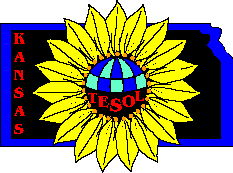Bits & Pieces of News
from Christopher Renner
Crenner@ksde.org
Resources
for teachers
“Help!
Kit” for Secondary Teachers of Migrant English Language Learners
The "Help! Kit" is a resource to assist middle and high
school teachers of migrant students. This comprehensive guide provides
practical, research-based strategies to effectively teach and evaluate
ELLs. Included in the kit are sections that are particularly relevant to
the needs of migrant secondary students.
The "Help!
Kit" was developed by the Eastern Stream Center on Resources and Training
(ESCORT), located at the State University of New York at Oneonta, a
national resource center dedicated to improving the educational
opportunities for migrant children. ESCORT maintains the National Migrant
Education
Hotline and also conducts professional and program
development activities for states, districts, and schools to help improve
services to migrant children and other ELLs. The "Help! Kit" is available from
the NCBE site at:
http://www.ncbe.gwu.edu/miscpubs/escort/secondaryhelpkit.html
or through ESCORT at: http://www.escort.org/
NEWS IN THE NATION
Census
Survey Suggests Greater Linguistic Diversity AND English Proficiency
On
Monday, August 6, the Census Bureau released initial data estimates from
the Census 2000 Supplementary Survey, including estimates of languages
spoken in U.S. homes and self-reported English proficiency. This survey of
700,000 households nationwide provides an early glimpse of data collected
in the Census 'long form'. The complete analysis of language data in the
Census isn't expected until Spring 2002.
According
to the Survey, a language other than English is spoken in approximately
18% of households. Linguistic diversity varies greatly
throughout the
country, from states such as Tennessee, Montana, South Dakota, Arkansas,
Kentucky, Alabama, Mississippi, West Virginia, where over 95% of the
population live in exclusively English speaking homes to states like
California, New Mexico, Texas, New York, Hawaii, Arizona, and New Jersey
where over 25% of the population live in homes where another language is
spoken.
While keeping in mind that the newly released
data are estimates, and may be subject to significant revision, a
comparison with 1990 census data reveals some interesting trends for the
school age population. First, there appears to have been a notable growth
in the proportion of school age children in homes where languages other
than English are spoken. In the decade from 1990 to 2000, the population
of children ages 5 to 17 living in homes where only English is spoken grew
just 11%, while the number of children living in homes where other
languages are spoken has increased
approximately 55%.
At the same time, the percentage of linguistic minority
children reported as speaking English "Very Well" has increased as well,
from 62% in 1990 to nearly 70% in 2000. According to the survey estimates,
approximately 86% of children in linguistically diverse homes were
reported as speaking English "Very Well" or "Well". There also appears to
be a corresponding decrease in the percentage of LCD children who speak
English "Not Well" or "Not at All"; from over 14% in 1990 to approximately
12% in 2000. Even though the percentage of children with difficulty in
English has decreased slightly, their numbers continue to increase along
with the rapid growth in linguistically diverse homes.
Of the over 9,700,000 children residing in linguistically
diverse households, the increase in the number of children in Spanish
speaking homes was most dramatic (60%), followed by children in Asian and
Pacific language homes (49%). The number of children in homes where
"Other" languages are spoken grew by 42%. Though all groups showed
advances in the percentage of students speaking English "Very Well",
children in Asian and Pacific language homes made the greatest gains (13%
increase).
For additional information on Census Survey data, visit
the U.S. Census Bureau at
http://www.census.gov,/ or the NCBE
State Pages at http://www.ncbe.gwu.edu/states
RESEARCH, PUBLICATIONS,
AND
other RESOURCES
Introduction to the TESOL Standards
in Spanish
The
introduction to the ESL standards, published as "Promising Futures" by
Teachers of English to Speakers of Other Languages, Inc. (TESOL), is now
available in Spanish. This translated version helps Spanish-speaking
parents understand the ESL standards and their importance to their
children's education.
"Introducción:
futuros prometedores: Normas de ESL para los estudiantes de Pre-K - 12" is
available at: http://www.tesol.org/assoc/k12standards/resources/pf-spanish.html
The
English version, "Promising Futures," is
available at:
http://www.tesol.org/assoc/k12standards/it/03.html
Federal Resources for Educational
Excellence (FREE)
At http://www.ed.gov/free/ the U.S.
Department of Education houses hundreds of educational resources from more
than 40 federal agencies. Teachers, parents, students, and others are
invited to search FREE for teaching and learning resources. Following is a sampling of
resources that may be applicable to the education of culturally and
linguistically diverse learners.
"American Masters: Edward Curtis" offers an essay, timeline, and
additional information about this photographer who took more than 40,000
images and recorded rare ethnographic information from over 80 American
Indian tribal groups, ranging from the Eskimo and Inuit people of the far
north to the Hopi people of the Southwest.
http://www.pbs.org/wnet/americanmasters/database/curtis_e.html
"Ancestors in the Americas," a companion website for the PBS series
by the same name, explores the history and stories of Asian Americans. A
timeline shows events that shaped Asian American history, and a resource
section allows further exploration of the Asian American experience. The
site includes guides with discussion questions for teachers and an online
discussion.
http://www.pbs.org/ancestorsintheamericas/index.html
Nation's
Changing Diversity Mapped in Census 2000 Atlas
An
atlas with 72 color maps illustrating demographic patterns and changes in
population between 1990 and 2000 has been released by the Commerce
Department's Census Bureau. "Mapping Census 2000: The Geography of U.S.
Diversity" uses data from the Census 2000 redistricting summary files.
Topics covered include total population, race and ethnicity, and
population under age 18. Each map features county-level detail for the 50
states, the District of Columbia and Puerto Rico.
"Mapping Census 2000" is
available at:
http://www.census.gov/population/www/cen2000/atlas.html. For a print version of this
product, contact the Census Bureau's Customer Services Center at (301)
763-4636.
Christopher
E. Renner
Program Consultant, ESOL/Bilingual, Refugee,
and Indian Education
Consolidated and Supplemental
Programs
Kansas State Department of Education
120 SE 10th Ave, Topeka, Kansas 66612
Tel.
785-296-7929
